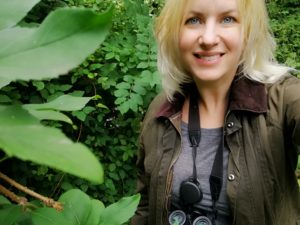Systems Thinking: A Best Practice Response to the Biodiversity Crisis – by Victoria Price
 At this year’s CIEEM Summer Conference, the keynote speaker, Diana Pound CEnv FCIEEM, encouraged everyone to incorporate ‘systems thinking’ into their conservation work. Here Victoria Price, a Conservation Strategy & Management Specialist, describes her approach to systems thinking.
At this year’s CIEEM Summer Conference, the keynote speaker, Diana Pound CEnv FCIEEM, encouraged everyone to incorporate ‘systems thinking’ into their conservation work. Here Victoria Price, a Conservation Strategy & Management Specialist, describes her approach to systems thinking.
This year, the CIEEM Summer Conference was a real call to action for all of us working across the environmental sectors. It focused on ‘professional approaches & practical actions’ to respond to both the climate and biodiversity crises. One of the major takeaways for me was the need to introduce, upskill and embed systems thinking approaches into our sector to increase our impact.
What is systems thinking?
For me, systems thinking is all about thinking about the bigger picture. If conservation practice has taught us anything over the last 40 years, it’s that to deliver effective conservation projects, we need to think beyond the ecological context and integrate social, economic and wider factors that govern all of our daily lives in the present day. And it’s no different for wildlife. Like it or not, the political, individual and economical decisions that are made everyday determines the future of all of the habitats in our World – even in the polar regions.
The above won’t really be news to anybody reading this – we all talk about stakeholders and collaboration and we all know it’s important. Nonetheless, many of us conservationists and ecologists avoid ‘systems thinking’ because it’s seen as too complex and overwhelming to address. ‘Maybe the development sector can deal with that’ we think. Or ‘someone else’? However, systems thinking is possible, and I truly believe if we ignore these wider influences, we are doing our natural world and our conservation colleagues a disservice.
Systems thinking in practice
As with everything in life, there’s no one ‘right’ way to do systems thinking. There are lots of different approaches, and there are pros and cons to each approach. However, a very common way to incorporate systems thinking into your work in the conservation sector is through creating a ‘theory of change’.
A theory of change approach outlines the change you want to make in the world, and the steps you will take to achieve that change. It encourages organisations not to think what they are doing day to day, but the impact they are making on the ground. A strong theory of change will incorporate anything and everything affecting the progress of the project, so they typically include social, cultural, economic and political aspects. As an example, a project trying to achieve habitat restoration might have outcomes such as securing land rights or improving and diversifying crop yields.
Why should I use it?
Any project with a conservation goal should include systems thinking if they truly want the money spent to be impactful and effective. Presently, most major conservation donors are focusing on the ultimate impact their money makes. Therefore it’s only a matter of time until this becomes industry standard as well as feeding into other funding mechanisms and Corporate Social Responsibility projects.
Systems thinking also encourages a participatory approach so, if done well, it will allow you to meaningfully engage stakeholders early on, as well as improving your project strategy. That’s because to do a theory of change well, you need diverse views including the views of people you both agree and disagree with. Therefore, I always recommend that theory of change workshops include people from different backgrounds and preferably representing the key stakeholder groups in your area. The reason to do this is because we must recognise that our perception of the world is different to everyone else’s. So our perception of the land and its value is both real and a myth.
By combining differing perceptions, you can get a better and a fuller picture of the landscape, seascape or catchment in which you work and ultimately identify common goals between different interest groups. By really hearing the perceptions of business people, land managers and people who live closest to nature we get more information on the ‘system’ in which we work and our management responses are more likely to work in the real world. By integrating a systems approach, you will invariably identify new and significant barriers that you are not yet addressing. And this is why focusing on the wider system can be a game changer.
How can I try it?
Having said all of the above, I’m not suggesting you invite your staunchest opponents to pick your work apart. Create a small and informative yet diverse group and set aside a couple of days to really think about the ultimate goal and wider context of your work. Using the context you can then brainstorm activities that will be the most effective in responding to the conservation problem.
For absolute beginners, as a first step, rather than going into a straight consultation with every stakeholder you know, you might want to try sketching out a mini theory of change (a.k.a. a project plan) in your notebook over the next 20 minutes.
To do this, imagine your own picture of what the project looks like in 15 years’ time and write it down. This is your ‘vision’, or the change you want to make. After that, simply write down all of the reasons that are stopping your vision from being realised today – as many as you can think of. The issues you identify may overlap with things you already know and work on, but try to dig deeper and perhaps think about the people living there and the businesses operating there and the challenges they face day-to-day. How might all these factors currently be stopping your vision?
This approach should help you identify several issues that are influencing your work. This doesn’t necessarily mean you should work on it (and there may be good reasons why you don’t already) but it might help you understand the wider context and to ultimately increase your conservation impact.
What next?
You may want to next try this approach with a wider group as part of a workshop and integrate your systems approach into your work planning and partnership work. Otherwise you may want to present this view of the world to others.
Most theory of change models are formatted in a flow chart with the problems turned into outcomes, which feed into the long-term vision of the conservation work. However, a theory of change can also be presented as a log frame, or even as a narrative, so you can present it in the format you’re most comfortable with.
Your theory of change can be used in all areas of your work including project design, work planning, proposals and communications frameworks. It also provides the basis for true collaboration and across sectors including utilities companies, charities, land managers and local communities. The world is your oyster!
Diana’s recommendation that systems thinking is a critical approach to achieve progress speaks to me. I’ve seen first-hand how this systematic and strategic approach to biodiversity problems can completely transform and improve our response as professionals. More organisations need to start including the wider system into their working practice if we are going to achieve a step change in wildlife conservation. Therefore, I hope this blog has been a useful primer in systems thinking and has provided you with at least one practical approach to integrating the wider context into your approach. I am confidant taking such steps will dramatically increase your impact on biodiversity.

Victoria Price MCIEEM is an independent consultant who provides strategic planning and conservation project management services to wildlife practitioners. She has worked with projects all over the world and specialises in sharing practical approaches to improve conservation impact and learning. Alongside her fundraising and management services, Victoria regularly provides theory of change workshops and training to conservation professionals. Find out more about her work at www.visionwild.co.uk.
Blog posts on the CIEEM website are the views and opinions of the author(s) credited. They do not necessarily represent the views or position of CIEEM. The CIEEM blog is intended to be a space in which we publish though-provoking and discussion-stimulating articles. If you’d like to write a blog sharing your own experiences or views, we’d love to hear from you at enquiries@cieem.net.
